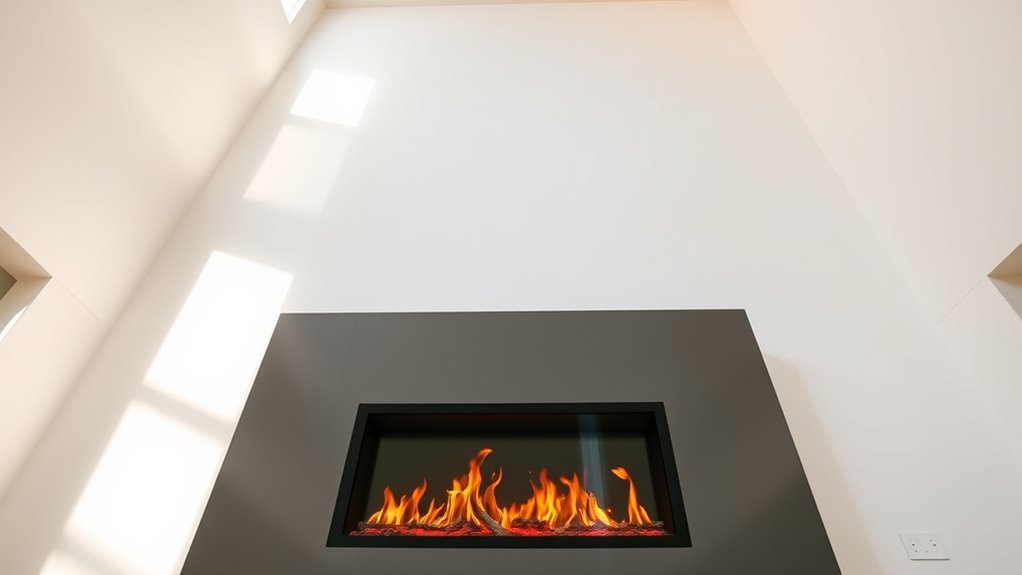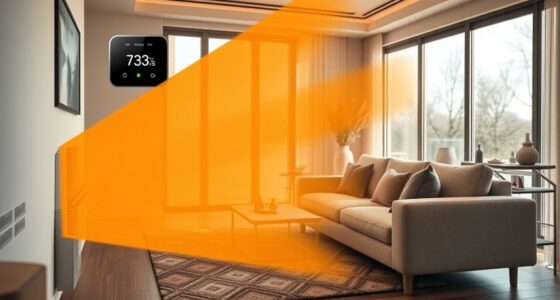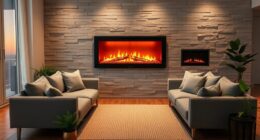When your ceiling height is high, your electric fireplace needs to work harder to heat the space evenly because warm air rises quickly and disperses in the larger volume. Proper placement, wattage, and good ventilation are key to maintaining comfort. Taller ceilings can cause cold spots and make heating less efficient if not properly managed. Keep exploring to discover how you can optimize your setup for cozy, balanced warmth in high-ceiling rooms.
Key Takeaways
- Higher ceilings cause heat to disperse quickly and rise, reducing warmth at lower levels.
- Adequate ventilation and airflow enhancements are essential for even heat distribution in tall spaces.
- Selecting an appropriately powered electric fireplace ensures efficient heating in large-volume rooms.
- Proper placement and design integration help optimize heat flow and maintain room aesthetics.
- Balancing fireplace size, ventilation, and room volume is key for effective and energy-efficient heating.

When it comes to heating your home efficiently, ceiling height plays a critical role. Higher ceilings can create a spacious, airy feel, but they also influence how well your electric fireplace performs. One key aspect to contemplate is ventilation considerations. With taller ceilings, heat disperses more quickly and tends to rise, making it harder to maintain consistent warmth at lower levels. You might find that your electric fireplace needs to work harder or be placed strategically to compensate for the increased volume of space. Proper ventilation becomes essential to guarantee that warm air circulates effectively, preventing cold spots and ensuring the heat is evenly distributed throughout the room. You may also want to explore additional heating accessories or fans to improve airflow, especially in rooms with very high ceilings. Additionally, selecting a suitable wattage electric fireplace is crucial to ensure adequate heating capacity for larger spaces. Aesthetic integration is another important factor. Taller ceilings often mean larger, more prominent fireplaces or feature walls to create a balanced look. You want your electric fireplace to blend seamlessly with your room’s design without feeling out of place or overwhelming the space. Consider how the fireplace’s size, style, and placement will align with your ceiling height and overall aesthetic. An overly large or poorly integrated fireplace can disrupt the visual harmony of a room, especially when ceilings soar high above. Conversely, choosing a sleek, minimalist electric fireplace can enhance the room’s aesthetic without dominating it. You might also opt for wall-mounted units or models that have a modern appearance, which tend to integrate well into high-ceilinged spaces. In rooms with high ceilings, you should also think about how the fireplace’s heat output matches the room’s volume. Electric fireplaces vary in their wattage and heating capacity, so selecting one suited to your space is essential. If the fireplace isn’t powerful enough, the temperature may struggle to rise to a comfortable level, making the room feel colder despite the presence of the heater. Conversely, an oversized unit could lead to overheating or energy inefficiency. Proper placement, combined with an understanding of ventilation considerations and aesthetic integration, helps optimize performance. It’s about balancing function and form—ensuring your electric fireplace heats effectively while complementing your room’s design. Ultimately, managing heating in spaces with high ceilings requires thoughtful planning. You need to address ventilation considerations to promote even heat distribution and choose an electric fireplace that aesthetically fits your room. When you pay attention to these details, your home stays cozy, stylish, and energy-efficient, regardless of ceiling height.
Frequently Asked Questions
How Does Ceiling Height Affect Electric Fireplace Energy Efficiency?
Higher ceilings can reduce your electric fireplace’s energy efficiency because heat distribution becomes less effective, causing your unit to work harder to warm the room. You might notice uneven heating and increased energy use. Additionally, consider aesthetic factors; taller ceilings can make fireplaces look more impressive but may require larger units or supplemental heating to optimize performance and maintain a cozy atmosphere.
Do Taller Ceilings Make Heating Less Effective With Electric Fireplaces?
Taller ceilings can make heating with electric fireplaces less effective because heat rises, making it harder to warm the space efficiently. To improve performance, you should consider chimney design adjustments and add ceiling insulation to retain heat better. These measures help prevent heat loss through the ceiling and ensure that the warm air stays in your room, compensating for the challenges posed by higher ceilings.
Can Ceiling Height Influence the Lifespan of an Electric Fireplace?
Ceiling height can influence the lifespan of your electric fireplace, as taller ceilings often require more extensive ceiling design considerations. If your space isn’t properly ventilated or the fireplace is overworked trying to heat larger areas, it may reduce its durability over time. Proper installation and maintenance help protect your fireplace’s durability, ensuring it lasts longer regardless of ceiling height. Regular upkeep is key to maximizing your electric fireplace’s lifespan.
Are There Specific Electric Fireplace Models Suited for High Ceilings?
You’ll find that certain electric fireplace models are ideal for high ceilings, enhancing your fireplace placement and aesthetic considerations. Look for models with adjustable flame effects and powerful heating elements to fill larger spaces effectively. These fireplaces often feature taller designs or custom inserts that complement lofty rooms, providing both visual appeal and efficient heating. Choosing the right model guarantees your high-ceiling space feels cozy and stylish, seamlessly blending function with design.
How Does Room Insulation Interact With Ceiling Height in Heating Performance?
Your room’s insulation considerably impacts heating performance, especially with high ceilings. Good thermal insulation helps retain heat, making your electric fireplace more efficient. Conversely, air leakage allows warm air to escape, reducing effectiveness. When ceilings are tall, maintaining proper insulation and sealing leaks becomes even more critical to ensure your fireplace heats the space evenly and efficiently, saving energy and increasing comfort.
Conclusion
Think of your room like a cozy forest clearing. When the ceiling is tall, it’s like a vast sky, making your electric fireplace work harder to warm the space. But if you keep the “sky” closer, the fire’s glow is more focused and effective, like a campfire warming you instantly. So, remember, lowering the ceiling isn’t about shrinking your room—it’s about letting your fireplace’s warmth reach you more quickly, turning your space into a comforting haven.









